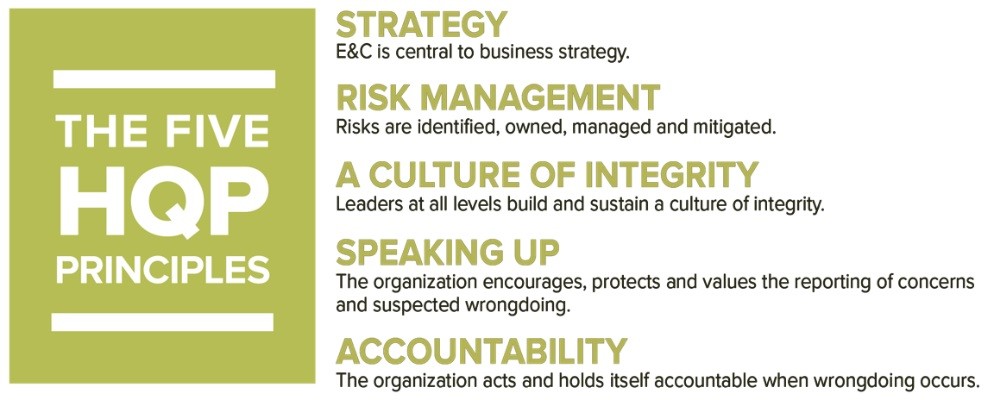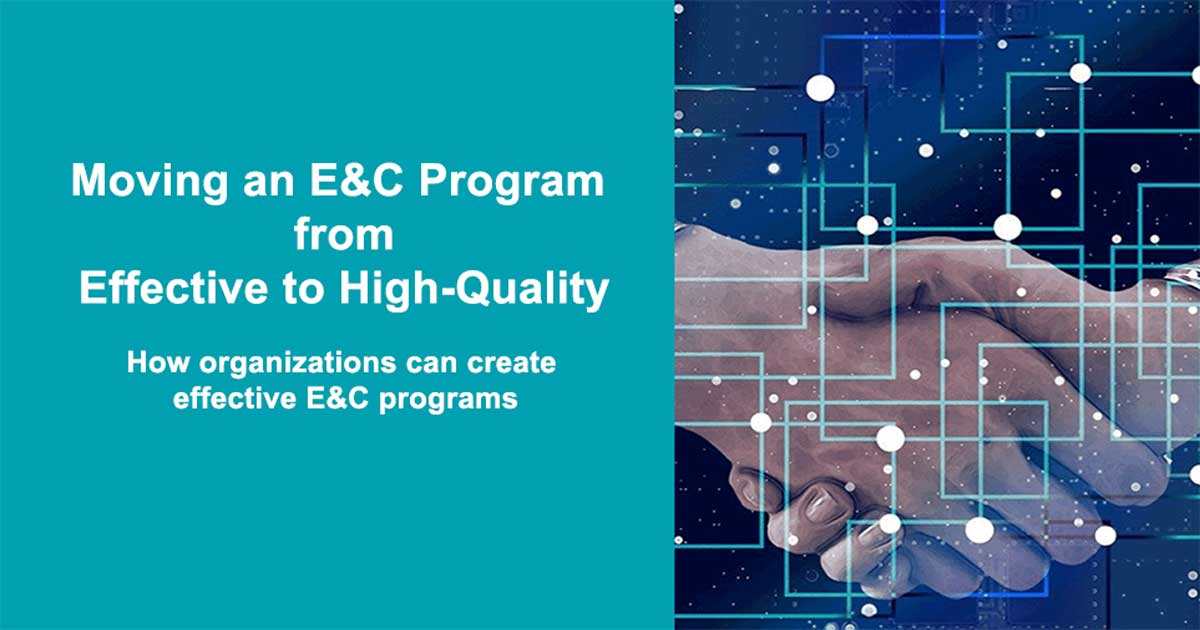In our last post, we looked at how organizations can create effective ethics and compliance programs. In this last of our series, we explore how trailblazing organizations take this a step further and create high-quality ethics & compliance programs.
Organizations with high-quality ethics and compliance (E&C) programs go beyond merely complying with applicable laws to transform a workplace. As we outlined in our last post, effective E&C programs help organizations build stronger workplace cultures, decrease employee turnover and create positive return on investment (ROI). Unfortunately, most guidelines for “effective” E&C programs outline only the minimum regulatory standards designed primarily to assist judicial evaluation rather than to serve as models for program design and implementation.
There is hope, however. Exemplary organizations from a wide variety of sectors and industries that have raised the bar higher than mere legal compliance can serve as role models for others. These trailblazers are not satisfied with the mere compliance or “check the box” E&C efforts. Instead, they have transformed their workplaces to create environments in which doing the right thing is standard operating procedure.
ECI refers to these organizations as having High-Quality Programs (HQPs) that assign a larger purpose to ethics and compliance by:
- Making it central to their business strategy.
- Placing a premium on ethical decision making; and
- Encouraging employees to speak up.
To better understand how these programs are achieved and the key features they include, ECI created a The Principle and Practices of High-Quality Ethics & Compliance Programs. The Blue-Ribbon Panel report lays the groundwork for what an HQP includes and outlines why it is important to achieve an E&C standard far beyond the minimum established by the Department of Justice.

The ECI report was prepared by a panel of prominent ethics and compliance practitioners, academics, white collar and whistleblower attorneys, as well as former enforcement officials. In it, they provide details about E&C programs that go beyond the minimum standard and discuss five core principles that are shared by these organizations:
Principle 1: Ethics and compliance is central to business strategy.
In organizations with HQPs, E&C is not an “add-on” function. Rather, it is designed to complement and support the organization’s strategic objective. It has its own place on the organizational chart and is considered an essential part of every business line. To support the integration of E&C into all of an organization’s operations, the program is afforded the resources (in terms of staff and funding) to do its work. The E&C program provides an independent voice in the organization; helps train business leaders in E&C; serves as a resource across the organization to support E&C efforts; and are visible contributors to high-level discussions of strategy, crisis management, the day-to-day operations of the organization and briefings to the board (or the equivalent).
Principle 2: Ethics and compliance risks are identified, owned, managed and mitigated.
Risk assessments are the foundation upon which HQPs are built. Every organization has a unique risk profile based on industry, history, maturity, marketplace and more. In HQPs, the E&C program is recognized as a key component of the enterprise risk-management effort, providing management and the board with critical information that can help to avoid severe business disruption and loss. An important characteristic of HQPs is that responsibility for risk is shared across the organization, as leaders assume ownership for the ongoing identification and mitigation of risks that are relevant to their areas. To support the effort, the E&C program is attuned to the most serious risks as they change over time.
Principle 3: Leaders at all levels across the organization build and sustain a culture of integrity.
Organizations with HQPs realize that minimizing risk does not, by itself, result in greater integrity. They understand that culture is the largest influencer of business conduct and that developing and sustaining a strong ethical culture is essential for protecting and sustaining the organization. In HQPs, leaders throughout the organization are expected – and held to – a shared responsibility for making ethical conduct and ethical decision-making a central part of the organization’s DNA. The E&C function in these organizations supports senior leaders so that they can, in turn, help build a culture of integrity by personally demonstrating an organization-wide commitment to ethics and compliance.
Principle 4: The organization encourages, protects and values the reporting of concerns and suspected wrongdoing.
Fear or reluctance to report erodes the culture of an organization. It not only impedes the flow of information that leads to detecting misconduct, but it also chills employee motivation and confidence to act in support of the organization’s integrity. To mitigate this, leaders in organizations with HQPs create an environment of openness in which employees are encouraged, prepared and empowered to raise concerns. Leaders also are equipped to respond appropriately if/when employees do come forward. This creates a “speak-up” culture that includes both a conducive atmosphere and leaders who possess and use effective interpersonal skills. Therefore, HQPs build skills in employees at all levels on how to act in alignment with the organization’s values, even in times of stress.
Principle 5: The organization takes action and holds itself accountable when wrongdoing occurs.
Woven throughout these principles is a notion of accountability that is central to the success of HQPs. It takes shape in several ways. First, even though staff members are assigned to the E&C program function, leaders at all levels throughout the organization are ultimately accountable for the identification/mitigation of risks and for the day-to-day priority given to E&C as part of a culture building effort. In the same way, the E&C program is accountable for continuous improvement – ensuring that the resources and support provided to leaders and employees are a reflection of the emerging priorities, activities and risks of the organization.
Investigations of reports of alleged wrongdoing in HQPs are timely, neutral, thorough, competent and consistent. Nevertheless, because there are consequences for wrongdoers, appropriate time is given to ensure accurate and fair results. In these organizations, investigations of significant matters may not be closed until proper referrals are made for issues that need further review or fact finding. When a violation is confirmed, the organization responds with appropriate consequences, regardless of the level of the violator. No exceptions are made because of an implicated person’s senior level or some other special status in the organization.
For more information on our updated HQP Assessment Tool, contact: hqp@ethics.org or visit www.ethics.org/hqp/.

